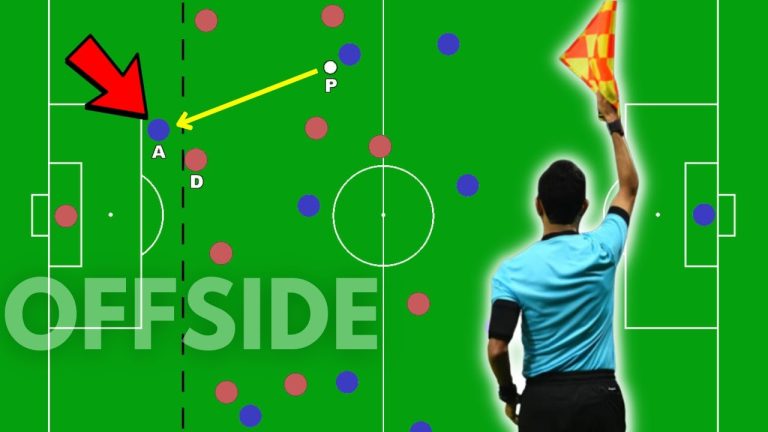The offside rule is a fundamental aspect of football that has been implemented across different leagues worldwide. However, its interpretation and application can vary greatly, adding an intriguing layer of complexity to the game. From the strict and precise enforcement in the English Premier League to the more lenient approach in the Italian Serie A, each league has its own unique take on the offside rule. In this article, we will explore how this pivotal rule differs between various leagues, shedding light on the subtle nuances that can significantly impact the outcome of a match.
What are the circumstances when offsides will not be called?
There are three notable exceptions where the offside rule does not apply. Firstly, players cannot be offside in their own half of the field. This means that even if they are ahead of the second-to-last defender, they will not be penalized. Additionally, offsides cannot be called from a throw-in, corner kick, or goal kick. This allows players more freedom to position themselves strategically without the risk of being called offside. Lastly, if the ball is intentionally played by a member of the opposing team, an attacker cannot be offside. This rule prevents unfair penalties in situations where the opposing team actively participates in the play.
In the game of soccer, the offside rule has a few exceptions that players must be aware of. One exception is that players cannot be offside in their own half of the field. This gives them more freedom to maneuver and strategize without the fear of being called offside. Additionally, offsides are not applicable during throw-ins, corner kicks, or goal kicks. This allows players to position themselves advantageously without worrying about being penalized for being in an offside position. Another exception to the offside rule occurs when the ball is deliberately played by a member of the opposing team. In such cases, attackers cannot be offside, ensuring fairness and preventing undeserved penalties.
Is the Premier League subject to an offside rule?
Yes, there is an offside rule in the Premier League. However, being in an offside position alone is not considered an offence. A player will only be penalized if they are in an offside position when their teammate passes or touches the ball, and they actively participate in the play. This rule ensures fair competition and discourages players from gaining an unfair advantage by positioning themselves strategically behind the opposition’s defense.
What is the recent update regarding offside?
In a radical departure from current regulations, the new rule regarding offsides, as outlined by Wenger, stipulates that a player will no longer be deemed offside if any part of their body aligns with the opposing last defender. This groundbreaking shift signifies a significant change from the existing guidelines, whereby players were required to keep their entire body, excluding their arms, behind or on the same plane as the last defender. The implementation of this rule aims to foster a more dynamic and fluid style of play, allowing for greater attacking opportunities and potentially reshaping the game as we know it.
Unraveling the Offside Puzzle: Decoding Rule Variations in Football Leagues
In the world of football, the offside rule has long been a source of confusion and controversy. With each football league having its own set of variations, decoding the offside puzzle has become an intricate task for players, referees, and fans alike. From the strict interpretation in the English Premier League to the more lenient approach in the Spanish La Liga, understanding the subtle rule differences can make all the difference on the pitch. Unraveling this puzzle is not only essential for players to avoid costly penalties but also for fans to fully comprehend the game and appreciate the tactics at play. Delving into the rule variations across different football leagues is a fascinating journey that sheds light on the complexities of the beautiful game.
As the world’s most popular sport, football has a rich tapestry of leagues, each with its own unique interpretation of the offside rule. From the Serie A in Italy, where the rule is applied with surgical precision, to the Bundesliga in Germany, where a more nuanced approach is taken, understanding the rule variations becomes an art in itself. These variations not only add to the excitement and unpredictability of the game but also pose challenges for players and officials who must adapt to different interpretations depending on the league they are competing in. By unraveling the offside puzzle and decoding the rule variations, we gain a deeper appreciation for the intricacies of the sport and the strategic decisions that shape each league’s gameplay.
From Premier League to La Liga: A Comparative Guide to Offside Rules
From the electrifying atmosphere of the Premier League to the technical brilliance of La Liga, one aspect of the beautiful game unites football fans across the globe: the offside rule. While seemingly simple on the surface, this fundamental regulation can often be a cause for controversy and heated debates. In the Premier League, a player is deemed offside if any part of their body, excluding the arms, is ahead of the second-to-last defender at the moment the ball is played. However, in La Liga, a player must be in an offside position and actively involved in the play to be penalized. Understanding these subtle differences is crucial for fans and players alike, as it not only shapes the strategies employed on the pitch but also adds an additional layer of excitement to the game. So whether you find yourself cheering on your favorite Premier League team or marveling at the precision of La Liga’s finest, keep an eye out for those crucial offside calls that can make or break a match.
Cracking the Code: Understanding Offside Rule Differences in World Football
Paragraph 1:
The offside rule is a fundamental aspect of football, but its interpretation varies across different leagues worldwide. Understanding the differences in offside rules is essential for players, coaches, and fans alike. In the English Premier League, for example, the offside rule is based on a player being in an offside position when any part of their body is closer to the goal line than both the ball and the second-to-last defender. Meanwhile, in Major League Soccer, the offside rule is more lenient, allowing players to be in an offside position as long as they are not involved in active play. These differences highlight the complexity of the offside rule and the need for a comprehensive understanding.
Paragraph 2:
One of the main reasons for the variation in offside rules is the desire to balance the game’s offensive and defensive strategies. Different leagues have different philosophies on how they want their games to be played, and this is reflected in their offside rules. Leagues with stricter offside rules, like the English Premier League, aim to encourage a faster-paced, attacking style of play. On the other hand, leagues with more lenient rules, such as Major League Soccer, prioritize an open and creative approach. By understanding the underlying philosophy behind each league’s offside rule, we can gain deeper insights into their footballing culture and strategies.
Paragraph 3:
While the offside rule may seem straightforward on the surface, its nuances and variations can have a significant impact on the outcome of a match. These rule differences require players to adapt their playing style and tactics when competing in different leagues or international competitions. Coaches must also carefully analyze these variations to develop effective strategies that exploit or defend against the specific offside rules in play. Additionally, fans who are well-versed in the offside rule differences can gain a deeper appreciation for the tactical intricacies involved in the world’s most popular sport. Cracking the code of offside rule differences is thus crucial for anyone looking to understand and appreciate the global game of football.
Offside Rule Exposed: Exploring League-specific Variations in Soccer
Offside Rule Exposed: Exploring League-specific Variations in Soccer
Soccer, the world’s most beloved sport, is governed by a set of rules that ensure fair play and maintain the integrity of the game. However, what many fans may not realize is that the offside rule, one of the most debated and controversial aspects of soccer, can vary from league to league. In some leagues, such as the English Premier League, a player is considered offside if any part of their body is beyond the last defender when the ball is played. Meanwhile, in other leagues like Serie A, players are only deemed offside if they are actively involved in the play. These league-specific variations not only add an extra layer of complexity to the game but also spark discussions and debates among fans worldwide. As soccer continues to evolve, it is fascinating to explore the nuances and differences in the offside rule across various leagues, shedding light on the diverse interpretations that shape the beautiful game.
In modern football, the offside rule is a vital component that ensures fair play and strategic gameplay. Its interpretation and implementation may vary across different leagues, adding an intriguing layer of complexity to the beautiful game. From the strict application in the English Premier League to the more lenient approach in lower-tier leagues, understanding the nuances of the offside rule becomes crucial for players, coaches, and fans alike. Regardless of the league, one thing remains constant – the offside rule continues to spark debates, fuel excitement, and shape the outcome of matches, cementing its significance in the ever-evolving world of football.



